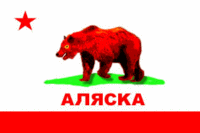Alyaska
| Conventional short name: | |
| Local: | Аляска Alyaska |
| English: | Alyaska |

| |
| Language: | Russian, Japanese, English, Brithenig, Native Languages |
| Script: | Cyrillic |
| Cities: | |
| Capital: | Novo Arkhangelsk |
| Other: | Berega Danilevsky, Nome, Novy Sankt-Peterburg |
| Independence: | from Japan |
| Date: | 11 April, AE 1 24 April, 1954 |
| Currency: | Ruble = 120 Kopecks |
Alyaska is a former Russian territory in far northern North America. Most of the inhabitants that are not native Alyaskans are of Russian or Japanese descent. The territory became part of the Empire of Japan in 1905 following the First Russo-Japanese War.
Contrary to popular belief, Alyaska is not Communist.
History
The Gold Rush, which started off when a Russian mining engineer discovered gold on the Kenai Peninsula, continued through 1914. Gold fever brought in many immigrants from the NAL and other North American lands, but the Russian culture is still very much alive amongst the descendants of Scottish, English, Kemrese, Tejan and Alta Californian gold miners. Alyaska started out as something of a Russian gulag and later (after the First Russo-Japanese War of 1903-1905) Japanese, where many sorts of undesirables were deported hopefully to disappear. The Russians chose Alyaska when Siberia became too good for the dissidents. Alyaska formally gained independence (from the Empire of Japan) on April 24, 1954 (Gregorian, April 11, AE 1 Alyaskan).
Novo Arkhangelsk was the capital in the Russian colonial era, but was stripped of the title under Japanese rule. It was restored in 1954 with the restoration of the republic.
Geography
Borders
North: Arctic Sea
West: Bering Strait (Separating the country from Chukotka)
South: Pacific Ocean
Southeast: Oregon
East: NAL
Economy
Alyaskan industry focuses largely on the lumber industry, as well as fishing, although there is a growing niche for oil with the discovery of Arctic oil reserves. The discovery of oil has fueled the growth of Danilevskovo Zalivah, the Alyaskan oil-production center on the Arctic Ocean. Plans have been suggested for an overland pipeline to help protect the permafrost of the north, as shipping from the frozen port is not an option many months of the year.
Culture
An interesting fact about Alyaska is that the International Date Line runs along Alyaska's land borders, marking one of the only two places in IB (the other around the condominium of Meidji-dò, where the International Date Line crosses solid land. Thus, Alyaska is always one day ahead of *here*'s Alaska.
Alyaska retains the Julian calendar, but counts years on the Alyaskan Era, which begins in Gregorian 1954 when the republic was founded.
The city of Nome is the see of the Assyrian Metropolitan of the Americas.
Religion
The majority of inhabitants are Russian Orthodox, Xintò, or Protestant. Some of the most picturesque "onion domes" are to be found in the population centres of Alyaska. There is also a smaller, but sizeable minority belonging to the Assyrian Church of the East, descendants of deportees from the parts of Russia where there are Assyrian minorities, for example southern Siberia and Qazaqstan.
61% Orthodox Christian, 14% Protestant (9.5% Presbyterian, 2.1% Lutheran, 1.65% Quaker, .75% Baptist), 9% Shinto/Buddhist, not religious 6%, 3.25% Assyrian Church, 3% Catholic, 3.75% remaining/other (inc. Mormon).
See also
LINK(S) TO EVENTUAL WEBSITE(S) -->